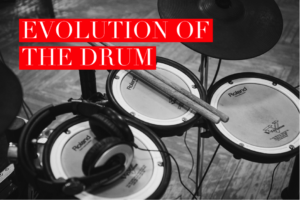
Over seven thousand years ago, the first drum was allegedly created, and even more astounding than that, it was most likely the first ever instrument. Indeed, the drum really is an instrumental – sorry for the pun – part of music culture, from popular music to religious and military ceremonies.
The first very simple types of natural made drums have been found in many archaeological digs, with the first example located in 5,500 BC in Neolithic China. This primitive model of wooden shell covered by stretched alligator skin, was largely the template for drums across entire Asia, the Middle East and Africa, where drums were used for thousands of years.
The first encounter of European more modern design came during the reign of ancient Greece and Rome, who dispersed drums that were traded from Africa across central and Western Europe. However, despite this trade, drums were very rarely used in Europe and continued to only dominate Asia, the Middle East and Africa.
However, this changed significantly after European armies came back home following crusades, with newly discovered knowledge and objects that marked the beginning of the European Renaissance. As trade across Europe developed, so did the influence of the drum as it made its presence as a main and secondary instrument in rhythm sections of both folk and classical music.
The presence of drums in orchestras continued to evolve, until in 1909, the Ludwig Company introduced a true revolution – a foot pedal to beat the bass drum. This marked the beginning of the modern drum kits that we know and use today, as the music of the roaring 20s and the jazz movement of the 30s developed. The drum kit hit a further evolution with the launch of rock n’ roll in the 1940s and, by 1960, the four-piece drum kit became commonplace in every rock, jazz and blues band, with many drummers tailoring the base configuration to their needs.
This fabulous – and essential – musical instrument still continues to evolve. The technical evolution of the 21st Century has seen the introduction of more advanced electronic rhythm sections, resulting in many musicians making a significant move to computer-controlled systems.
What’s next, we wonder, for this remarkable instrument?

Prehistoric times – It is believed that drums made from natural objects were the first musical instruments used by modern mankind.
5500 BC – First recorded appearance of drums made from alligator skins. They were originally made in Neolithic cultures from China, but that knowledge reached across Asia in the next few millennia.
3000 BC – Bronze Dong Son drums were made in northern Vietnam.
1000- 500 BC – Sri Lanka and African people used drums as a means of communication over large distances.
500 BC – Tako drums arrived in China from Japan.
200-150 BC – African drums were widespread in Greece and Rome.
1200 AD – Opening of the Mediterranean trading routes by the Crusades brought incredible wealth to Genoa and Venice, enabling spreading of Middle Eastern, African, Indian and Asian influences over Europe. Among those new influences was also the use of drums.
1450 – Large expansion of various percussion instruments. These medieval prototypes became the basis of modern percussions.
1500 – African drums arrive in America via slave trade.
1600 – Most popular percussion instruments in Renaissance – timbrels, tabors, long drums, snare, monk bells and jingle bells. European military adopted drums for easier communication between commanders and troops.
1650 – Creation of the first version of snare drum.
1800 – Popularisation of bongos in Cuban folklore music.
1820 – Most popular percussion instruments of the Classical period of music – kettle drum, snare, gong, vibraphone, whip, triangle, marimba and tambourine. Drums were used in orchestras, with professional musicians and composers preforming complicated musical pieces.
1890 – First appearance of drums that were hit by foot pedals and drum set.
1904-1909 – First Patent for foot pedal, and creation of first professional drum sets.
1920s – First regular appearance of hi-hat stands in drum kits.
1930s – Four-piece kit becomes popular.
1940s – Double bass drum kit used by Jazz drummer Louie Bellson.
1960s-80s – Drum sets become larger and elaborate.
1973 – Appearance of first simple electric drum set. It was made by Karl Bartos.
1982 – Swedish group Asocial first used “blast beat” drumming technique. The term “blast beat” was popularised by metal bands Sepultura and Napalm Death.
Late 1900s- early 2000s – Drums are an integral part of musical bands, with more and more electronic bands using computer generated drum sets.

A typical kit is centred on the snare drum on which the player plays in time with the music. It has wires running across the skin stretched across the bottom of the drum, giving it a sharp sound that cuts through most other instrumentation. The snare is used in conjunction with the bass (or kick) drum, which sits on its side and is played with a foot pedal.
Kits will usually have one or more tom-toms of different diameters and depths, which are used to provide additional sounds. Mounted toms sit atop the bass drum or on special stands. Floor toms have their own legs and stand on the floor.
Drummers will use a variety of cymbals. Crash and ride cymbals of various sizes, weights and materials are suspended from stands so they may ring freely. Hi-hats (which first appeared in about 1926) consist of two cymbals sitting on top of each other and are used along with the snare and the bass drum to provide the foundation of the beat. Hi-hats sit in a special stand with a foot pedal that allows the drummer to separate and clash them together for rhythmic effect.
Harmeet February 26th, 2018
Posted In: Uncategorised